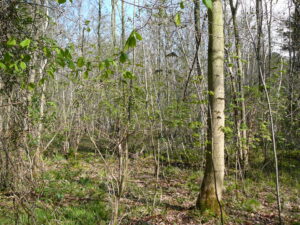Rooting the Northern Forest: soil and woodland dynamics across northern England
Tree-planting is an important strategy for carbon capture across the globe wherever trees can be grown. Many of these landscapes have been substantially deforested by a mixture of human activity and natural processes over the last few thousand years, which has in turn altered the soils present, through erosion, weathering and changing land cover and land use. The history of woodland in a landscape with varied geology and topography, its composition, its interaction with human activity and climate, and its decline, provides important insights to inform decisions about future land management, but the post-woodland changes in soils properties present additional complications for tree restoration. Tree planting on some denuded soils on carbonate-rich bedrock might lead to initial net carbon release for decades or centuries due to increased breakdown of the bedrock by roots and by the acidity of woodland soil forming processes, until the system matures and bedrock burial along with soil carbon storage shifts the system to net carbon storage.
The soil at a site is the product of the climate, the relief, the substrate, the landcover and biota present, and time since soil formation began, but our understanding of soil formation trajectories is largely based on studies of a few decades or extrapolation from “natural experiments” e.g. glacial retreat time sequences. Pollen analysis datasets enable us to reconstruct past land cover over thousands of years in increasingly quantitative ways (e.g. Bunting et al. 2018; Serge et al. 2023), and recent developments show that plant functional traits can be applied to palaeoecological data to reconstruct major soil properties and their temporal dynamics (e.g. Kunes et al. 2011; Brown et al 2023). This project will combine these approaches to reconstruct the dynamics of both woodland and soil in a case study area, the Northern Forest zone in Northern England.
 In the north of England, soil formation began at the end of the last ice age, and relief and substrate have been effectively constant over that time period but are both highly varied in space. Landcover however has been dynamic, and the intervention of humans means that different areas were deforested at different points in time, and some may have escaped it althogether as they still support ancient woodland which seems to have been present for hundreds or even thousands of years. This makes it an excellent study area for exploring the long term trajectories of soils in the temperate deciuous forest zoneand the extent to which studying past and present woodland can effectively inform planning for planting new woodlands appropriate for the soils and climates. The proposed Northern Forest region offers potential for effective collaboration and application of findings.
In the north of England, soil formation began at the end of the last ice age, and relief and substrate have been effectively constant over that time period but are both highly varied in space. Landcover however has been dynamic, and the intervention of humans means that different areas were deforested at different points in time, and some may have escaped it althogether as they still support ancient woodland which seems to have been present for hundreds or even thousands of years. This makes it an excellent study area for exploring the long term trajectories of soils in the temperate deciuous forest zoneand the extent to which studying past and present woodland can effectively inform planning for planting new woodlands appropriate for the soils and climates. The proposed Northern Forest region offers potential for effective collaboration and application of findings.
The project student will use modern datasets of soil condition and land cover to validate a functional traits from pollen assemblages reconstruction approach in northern England. They will then collate extensive existing pollen record data across the Northern Forest region, and use them to generate a spatially explicit reconstruction of the dynamics of land cover and soil properties across the region over time. Comparison with PMIP model run palaeoclimate data and archaeological data bases will offer insights into controls on the observed dynamics, and exploring the amount and direction of soil change since deforestation across the varied landscape will be used to develop general recommendations for how to use present and past woodland data to plan for future woodlands most effectively – e.g. should present day soil be the only basis, or can surviving woodland fragments or reconstructions of woodland before humans cleared it give additional valuable information?
Brown, K.A., Bunting, M.J. et al. (2023) Trait-based approaches as ecological time machines: developing tools for reconstructing long-term variation in ecosystems. Functional Ecology
Bunting, M.J. et al. (2018) Maps from Mud – using the Multiple Scenario Approach to reconstruct land cover dynamics from pollen records: a case study of two Neolithic landscapes. Frontiers in Ecology and Evolution 6 article 36
Kuneš, P. et al. (2011), Soil phosphorus as a control of productivity and openness in temperate interglacial forest ecosystems. Journal of Biogeography, 38: 2150-2164.
Serge MA et al. 2023 Testing the Effect of Relative Pollen Productivity on the REVEALS Model: A Validated Reconstruction of Europe-Wide Holocene Vegetation. Land. 2023; 12(5):986.
